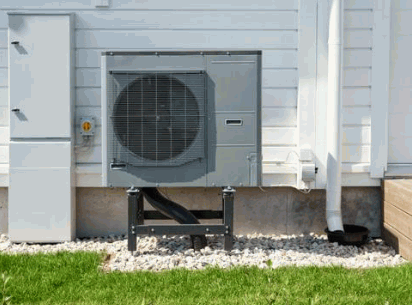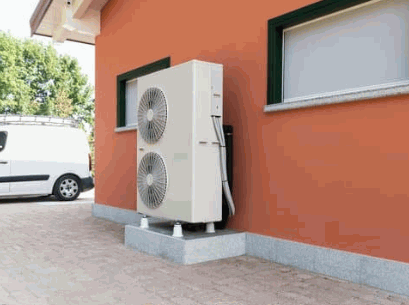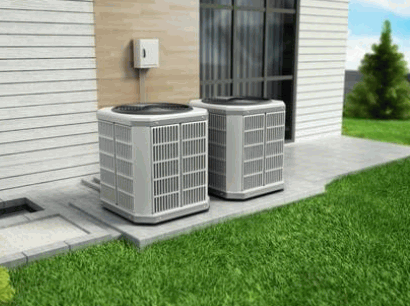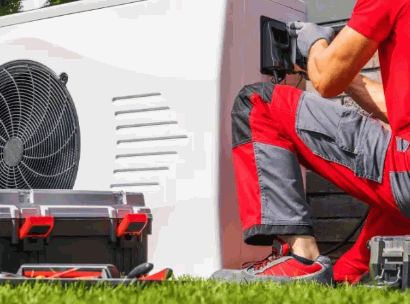In today’s world, energy efficiency and sustainability are more important than ever, and air source heat pumps are emerging as a leading solution for eco-friendly heating and cooling.
But what exactly is an air source heat pump, and how does it work? This article guides you through the ins and outs of air source heat pumps, exploring their benefits, potential drawbacks, installation processes, and maintenance tips.
Whether you’re considering a new heating system or just curious about this technology, you’ll find insights that can help you make informed decisions for your home.

What Is An Air Source Heat Pump?
An air-source heat pump (ASHP) is an innovative heating and cooling system that leverages outdoor air to efficiently regulate indoor temperatures, making it a popular choice in the HVAC industry. Unlike traditional fossil fuel-based heating systems, air-source heat pumps utilize the ambient temperatures to provide space heating in colder months and cooling in warmer months, thus significantly improving energy efficiency. Additionally, these systems can also provide domestic hot water, making them versatile options for homeowners looking to reduce their carbon footprint while enhancing indoor air quality.

How Does An Air Source Heat Pump Work?
An air-source heat pump operates by transferring thermal energy between indoor and outdoor environments using a heat exchanger, which facilitates the flow of refrigerant in both heating and cooling modes.
Understanding how this system functions is key to appreciating its efficiency and effectiveness.
The flow of refrigerant plays a pivotal role in this process, circulating through the system in a closed loop to absorb and release heat as it changes from a liquid to a gas and back again.
For heating, the refrigerant is compressed to increase its temperature, allowing it to draw heat from colder outdoor air, even when temperatures are low.
The coefficient of performance (COP) is a critical measure of the system’s efficiency, representing the ratio of heat output to energy input. Higher COP values indicate better energy savings and performance.
Variations in both indoor and outdoor temperatures can significantly impact heating capacity—when the temperature differential is less, the system can operate more efficiently, leading to enhanced energy conservation.

What Are The Types Of Air Source Heat Pumps?
There are primarily two types of air-source heat pumps: split systems and packaged heat pumps, each designed to cater to specific applications and preferences in a heating system. Split systems consist of two main components—an indoor unit that houses the evaporator and an outdoor unit that contains the compressor and condenser. On the other hand, packaged heat pumps combine all components into a single unit, making them ideal for spaces with limited installation options. Some models feature variable-speed compressors, enhancing energy efficiency and comfort by adjusting output based on real-time heating or cooling demands.
These systems are particularly favored in both residential and commercial environments due to their versatility and performance.
- In residential settings, split systems are often used in larger homes where ductwork is already in place, while packaged systems are more suited for apartments or smaller buildings with limited space.
- They also provide significant energy savings. By utilizing variable-speed compressors, these heat pumps can modulate their operation to maintain optimal comfort levels, improving overall HVAC system performance.
This adaptability not only reduces energy costs but also contributes to a more sustainable approach to heating and cooling.

What Are The Benefits Of An Air Source Heat Pump?
Air-source heat pumps offer numerous benefits, making them a compelling choice for homeowners and businesses alike. These systems are recognized for their exceptional energy efficiency, which translates into substantial cost savings on utility bills. By utilizing ambient temperatures for heating and cooling, air-source heat pumps significantly reduce reliance on fossil fuels, thereby contributing to lower CO2 emissions and a smaller carbon footprint. Moreover, their versatility allows them to provide not only space heating and cooling but also domestic hot water, enhancing their appeal in the HVAC industry.
Energy Efficiency
One of the primary advantages of air-source heat pumps is their remarkable energy efficiency, often quantified by a metric known as the coefficient of performance (COP). A high COP indicates that for every unit of energy consumed, the system can deliver multiple units of heating or cooling energy, significantly outpacing traditional heating systems that rely on fossil fuels. This efficiency is achieved through the optimal refrigerant flow in both cooling and heating modes, ensuring maximum heating capacity while minimizing energy consumption.
To understand the significance of the COP, it is essential to recognize how it is calculated. The COP is derived by dividing the amount of heating or cooling produced by the energy consumed. For instance, if an air-source heat pump uses 1 unit of energy to produce 3 units of heating, it boasts a COP of 3. This contrasts sharply with traditional fossil fuel systems, which generally operate at much lower efficiencies.
When you compare the long-term benefits of air-source heat pumps versus conventional systems, the savings in energy costs become evident:
- Reduced monthly energy bills due to greater efficiency
- Lower carbon footprint contributing to environmental sustainability
- Longer lifespan and lower maintenance costs
Ultimately, the choice of heating system not only impacts immediate comfort but can also lead to significant long-term financial savings and environmental advantages.
Cost Savings
Investing in an air-source heat pump can lead to substantial cost savings over time, despite potential higher installation costs compared to conventional heating systems. These savings arise from significantly reduced energy bills, as air-source heat pumps consume less energy to achieve the same heating or cooling output when compared to fossil fuel systems. Many air-source heat pumps qualify for energy efficiency rebates and incentives within the HVAC industry, further offsetting initial costs and enhancing return on investment.
The long-term cost benefits of choosing air-source heat pumps extend beyond mere energy efficiency.
- These systems typically have lower maintenance requirements, which can lead to reduced service costs.
- Unlike traditional systems that often rely on fossil fuels, air-source models harness renewable energy from the air, providing a sustainable heating and cooling solution that may mitigate future price increases for fuel.
- Homeowners may enjoy an overall increase in property value due to the installation of modern, energy-efficient heating systems.
When comparing these factors against the conventional heating systems, it becomes evident that air-source heat pumps not only offer a more eco-friendly option but also present a financially advantageous investment in the long run.
Environmentally Friendly
Air-source heat pumps are considered environmentally friendly alternatives to traditional heating systems that burn fossil fuels, primarily due to their ability to reduce CO2 emissions significantly. By harnessing ambient temperatures for heating and cooling, these systems minimize reliance on carbon-intensive energy sources, leading to lower greenhouse gas emissions. The energy efficiency of air-source heat pumps further enhances their eco-friendly appeal, making them a preferred choice for environmentally conscious consumers and businesses.
Not only do these systems significantly lower the carbon footprint associated with energy consumption, but they also contribute to a broader push towards sustainability. By using renewable energy sources for their operation, air-source heat pumps play a crucial role in combating climate change. As communities and nations commit to reducing their greenhouse gas emissions, the adoption of these technologies can lead to:
- Decreased dependence on fossil fuels: Transitioning to air-source heat pumps reduces the overall demand for oil, gas, and coal, which are major contributors to atmospheric CO2 levels.
- Long-term cost savings: While the initial investment may be higher, the efficiency of these systems often translates into lower energy bills over time, thereby encouraging sustainable financial practices.
- Improved air quality: Fewer emissions from heating systems result in healthier environments for both people and wildlife, promoting overall well-being.
Investing in air-source heat pumps not only supports individual energy efficiency goals but also aligns with global efforts to achieve a more sustainable future.
Versatility
The versatility of air-source heat pumps is one of their most attractive features, allowing them to function effectively as both heating and cooling systems while also providing domestic hot water. This dual functionality eliminates the need for multiple separate systems, simplifying installation and maintenance, and reducing overall installation costs. In the HVAC industry, air-source heat pumps are recognized for their adaptability to various climate conditions, making them suitable for a wide range of applications, from residential homes to commercial buildings.
Incorporating air-source heat pumps into a building’s design can lead to significant energy savings and increased efficiency.
- For instance, during warmer months, these systems can efficiently cool indoor spaces by transferring heat to the outside air.
- Conversely, in colder seasons, they absorb ambient heat from the outside to warm the interiors, even in areas like Minnesota and Maine where temperatures can be extremely low.
- Many models are equipped with advanced technology that allows them to operate effectively even in lower temperatures.
This flexibility not only enhances comfort but also aligns with sustainable energy practices, making air-source heat pumps an integral part of the ongoing evolution in HVAC solutions within the HVAC industry.

What Are The Drawbacks Of An Air Source Heat Pump?
While air-source heat pumps present numerous benefits, they also come with certain drawbacks that potential buyers should consider before making a decision. One of the primary concerns is the initial cost of purchasing and installing these systems, which can be higher than traditional heating systems like gas boilers. Additionally, air-source heat pumps exhibit a dependence on outdoor temperature, as their heating capacity may diminish in extremely cold conditions, affecting their performance in certain climates, especially cold climates. Furthermore, some models may produce noise during operation, which could be a consideration for homeowners.
Initial Cost
The initial cost of an air-source heat pump can be a significant factor for homeowners, often exceeding that of traditional heating systems like gas boilers. This higher expense frequently encompasses installation costs, which may vary depending on the complexity of the setup and specific requirements of the heating system. It is essential to view this initial investment in the context of long-term energy savings, as the efficiency of air-source heat pumps can lead to lower utility bills over time.
When evaluating the overall expense, it’s crucial to break down the components of the initial costs. These can include:
- Equipment costs: The price of the heat pump itself generally falls within the range of $3,500 to $8,000, depending on capacity and brand.
- Installation expenses: Labor and any necessary modifications to the existing ductwork or electrical systems can add another $1,000 to $5,000.
In contrast, traditional heating systems may have lower upfront costs but often lead to higher monthly expenses due to less efficient energy use.
By adopting more efficient systems, homeowners may find themselves enjoying substantial savings over the lifespan of the unit, and also contribute to reducing CO2 emissions.
Dependence On Outdoor Temperature
Air-source heat pumps exhibit a notable dependence on outdoor temperatures, which can affect their heating capacity, particularly in cold climates. As outdoor temperatures drop, the efficiency of the heat pump may decline, making it challenging to maintain comfortable indoor temperatures without supplementary heating sources. This limitation is particularly pronounced in regions with consistently low temperatures, where alternative heating systems might be required to ensure adequate performance during winter months.
When the mercury falls, the essential function of air-source heat pumps becomes increasingly compromised, as they struggle to extract sufficient heat from the frigid air. In fact, researchers have noted a substantial decrease in heating efficiency as temperatures drop below freezing, often resulting in reduced heat output. This issue is particularly evident in geographical areas characterized by persistent sub-zero conditions, making it crucial for homeowners to consider additional solutions.
- One effective approach is to pair these systems with a supplemental heating method, such as electric resistance heaters or radiant floor heating, ensuring that comfort levels are sustained even during the most extreme temperatures.
- Another viable consideration is to select modern heat pumps designed for colder climates, which incorporate advanced technology and higher performance ratings, effectively countering the adverse effects of low outdoor temperatures.
Investing in proper home insulation can also create a significant difference, trapping heat indoors and lessening the demand on the heat pump, thereby enhancing overall efficiency.
Noise
Some air-source heat pumps can produce noticeable noise during operation, which may be a consideration for homeowners seeking a quiet indoor environment. The sound generated can vary depending on the model and its components, particularly during the cooling mode when the outdoor unit is expelling heat. This noise may be more prominent in smaller homes or in close proximity to outdoor living spaces, potentially affecting indoor air quality and comfort levels.
For those who prioritize tranquility, it’s essential to evaluate the noise levels of air-source heat pumps compared to other HVAC systems like traditional air conditioners or gas furnaces. In fact, choosing an ENERGY STAR rated model can help ensure a quieter and more efficient system.
Generally, heat pumps operate around 50 to 70 decibels, a range similar to that of a refrigerator or regular conversation. This can be significantly louder than other options available. Here are some tips for selecting quieter units:
- Look for models specifically designed with noise reduction technologies.
- Consider units with variable-speed compressors that operate more quietly.
- Placement of the outdoor unit should be taken into account to avoid excessive noise near living spaces.
Soundproofing measures can be implemented, such as:
- Installing a sound barrier wall around the outdoor unit.
- Using vibration isolation pads to minimize vibrations transmitted to the building.
- Implementing landscaping features that act as natural sound barriers, such as shrubs or tall trees.
By taking these factors into consideration, homeowners can enjoy the benefits of efficient heating and cooling while maintaining peace in their living spaces, whether they are using air conditioning or heating modes.

How To Choose The Right Size Air Source Heat Pump For Your Home?
Choosing the right size air-source heat pump for your home is crucial to ensure optimal heating and cooling performance, as an improperly sized unit can lead to inefficiencies and discomfort in both heating and cooling modes. The correct sizing involves calculating the heating capacity required for the specific space, taking into account factors such as indoor air quality, home insulation, and local climate conditions. Engaging an HVAC professional can help homeowners determine the optimal size based on detailed assessments of their home’s unique requirements.

What Is The Installation Process Of An Air Source Heat Pump?
The installation process of an air-source heat pump involves several critical steps that require careful planning and execution to ensure optimal performance and compliance with industry standards. Initially, an HVAC professional will evaluate the home’s requirements, including indoor air quality and layout, alongside local outdoor temperature considerations. Following this, the installation typically includes placing the outdoor unit, connecting refrigerant lines, and setting up the indoor unit, all while adhering to relevant codes and regulations, which can impact installation costs.

How To Maintain An Air Source Heat Pump?
Maintaining an air-source heat pump is essential to ensure its efficiency and longevity, and it involves routine checks and servicing to address both heating and cooling mode performance. Regular maintenance tasks include cleaning or replacing filters, inspecting refrigerant levels, and ensuring that the outdoor unit is free from debris that may obstruct airflow. Homeowners can enhance indoor air quality and maintain optimal heating capacity by adhering to a consistent maintenance schedule, ideally conducted by a qualified HVAC technician.
Explore further: How To Clean Air Source Heat Pump

What Is The Lifespan Of An Air Source Heat Pump?
The lifespan of an air-source heat pump typically ranges from 15 to 20 years, depending largely on factors such as installation quality, maintenance practices, and usage patterns. Proper maintenance plays a vital role in extending the system’s longevity, as it ensures that all components function effectively and efficiently, thus maximizing heating capacity and overall performance. Additionally, factors such as local climate conditions and the quality of the initial installation can also impact the lifespan of the air-source heat pump, making it crucial to consider both air-source and ground-source heat pumps for optimal performance.

Are There Any Government Incentives For Installing An Air Source Heat Pump?
Many homeowners exploring the installation of an air-source heat pump may be pleased to discover various government incentives designed to offset installation costs and promote energy efficiency. These incentives often include tax credits, rebates, and financing options, which aim to encourage the adoption of renewable energy technologies within the HVAC industry. By taking advantage of these programs, homeowners can not only reduce their upfront expenses but also enjoy long-term energy savings, making air-source heat pumps a more appealing investment.
What Is The Difference Between An Air Source Heat Pump And A Ground Source Heat Pump?
Air-source heat pumps and ground-source heat pumps are both effective heating and cooling systems, but they operate on different principles and have distinct advantages that can impact energy efficiency and installation costs. An air-source heat pump utilizes outdoor air to provide heating and cooling, making it ideal for a variety of climates, whereas a ground-source heat pump, or geothermal system, leverages stable underground temperatures, typically offering higher efficiency but often incurs higher installation costs. Understanding these differences can help homeowners choose the right system for their specific needs.


